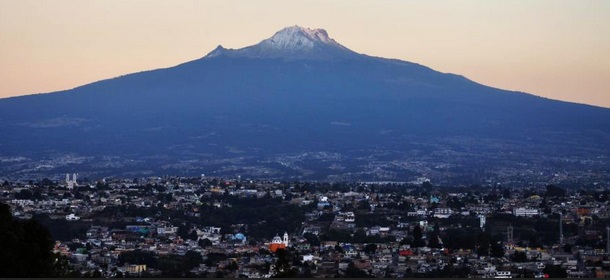Teach English in Tlaxcala

History
Tlaxcala sits within reach of Mexico City and Puebla (120 and 30 km respectively), and boasts one of the most beautiful historical town centers of all Mexico. The town played a pivotal role in the Spanish Conquest of Mexico, due to allegiance that was formed between the Tlaxcalans and the Spanish.
Tourism is now one of the main economic activities in Tlaxcala, due in part to the charming town, and its surroundings. The name “Tlaxcala” pre-dates the state by centuries; it derives from the name of the capital city, which was also used to denote the territory controlled by this city in pre-Hispanic times. According to some historians, the name comes from an ancient word “texcalli”, which meant crag; however, an alternative etymology stems from the Nahuatl word “Tlaxcallan” which means place of corn or maize tortillas.
The Aztec glyph that referred to this place has both elements, two green hills and two hands holding a corn tortilla. The state’s coat of arms is based on the coat of arms that was granted to the city in 1535. Its different elements have the following meanings: the red background represents courage; the castle symbolizes defensive power; the eagle with its open wings represents the spirit of vigilance; the border symbolizes protection and compensation; the green palms stand for victory, and the crowns are the symbol of royal authority. The letter I refers to Joanna of Castile, the mother of Carlos V; the letter K represents the name of the king himself; and the letter F belongs to Felipe, the son of Carlos V. The human skulls and cross-bones represent those who died during the Conquest.
Cost of living
Based on the standard dollar exchange value the cost of living in Tlaxcala ranges from US$600 to as little as US$350 a month. These figures are based on expenditure on housing, food, education, transportation, clothing, recreation, health, furniture, appliances and personal use. Monthly rents in Tlaxcala are around US$273.
A big feature of living in Mexico is that domestic help is relatively cheap compared to countries in the Western world. In Tlaxcala it’s common to pay around US$25 to a person (usually a woman) who will come and clean your apartment, iron clothes and if you’re willing to pay a bit extra, cook as well.
Natural geography and climate
Tlaxcala is a land-locked state situated on the Trans-Mexican Volcanic Belt. The average altitude for the state is 2,230 meters above sea level, making it a bit higher than the Valley of Mexico just to the southwest. The western part of the state lies on the central plateau of Mexico while the east is dominated by the Sierra Madre Oriental, home of the 4,461 meter La Malinche volcano.
Most of the state is rugged terrain dominated by ridges and deep valleys, along with protruding igneous rock formations. This ruggedness, along with large-scale weather phenomena such as the Intertropical Convergence Zone, gives the state a complex climate.
Overall rain patterns for the state are about 400mm in the summer rainy season and 30mm in the winter. Locally, however, this varies dramatically between the drier plateaus and valleys and the wetter mountains. Variations in altitude produce sub-climates between semi-tropical to temperate, with frosts likely in the higher elevations during the winter. Temperate forests of pine, fir (abies religiosa), evergreen oak (Quercus ilex) and junipers (Juniperus communis) dominate the mountain highlands while the flatlands, with their drier climate, are characterized by agaves and prickly pear cactus (opunita).
The state has no major lakes or extremely large rivers. Principle water sources are the Atoyac-Zahuapan basin and the reservoir of the Atlangatepec dam.












